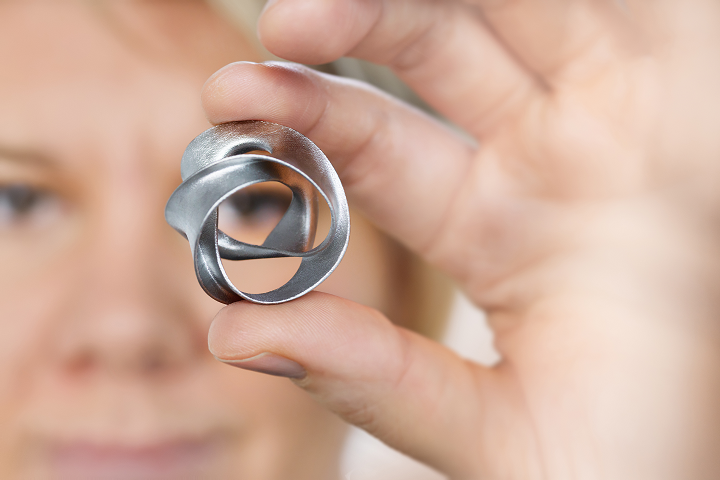Back in 2017, metal 3D printing company Digital Metal, founded in 2012 and later acquired by metal powder production leader the Höganäs Group, announced the commercial availability of its high-precision metal binder jetting system, the robust DM P2500 printer. The machine, with a print volume of 203 x 180 x 69 mm, was built for accuracy, able to make small and intricate parts for serial production of complex metal components. Now, the DM P2500 can count high speed as a feature, as the Sweden-based company has announced the launch of a new software upgrade that triples the system’s 3D printing speed.
 Digital Metal is the first company in the world to commercialize high-precision metal 3D printers for the production of small parts that feature advanced geometries and excellent surface finish. Its customers include such recognizable names as Bosch, CETIM (the French Technical Center for Mechanical Industries), Honeywell, Koenigsegg, Montfort Watches, MTC (The Manufacturing Technical Centre, UK), and Volvo. The company’s metal binder jetting technology has produced more than 500,000 components since it was first introduced, and Digital Metal’s recently expanded production plant in Höganäs has over 30 different geometries in serial production at the moment.
Digital Metal is the first company in the world to commercialize high-precision metal 3D printers for the production of small parts that feature advanced geometries and excellent surface finish. Its customers include such recognizable names as Bosch, CETIM (the French Technical Center for Mechanical Industries), Honeywell, Koenigsegg, Montfort Watches, MTC (The Manufacturing Technical Centre, UK), and Volvo. The company’s metal binder jetting technology has produced more than 500,000 components since it was first introduced, and Digital Metal’s recently expanded production plant in Höganäs has over 30 different geometries in serial production at the moment.
Two years ago, Digital Metal made a big announcement with the introduction of its fully automated production concept. Now, the new software upgrade to its DM P2500 3D printer increases its print speed by three times – allowing for much large larger production volume per time unit, while still maintaining the high quality of its components.
“We constantly work to improve the performance of our printers so that our customers can work as cost-effectively as possible. This important upgrade makes it possible to reach even greater production volumes without sacrificing component quality. We plan to continue introducing similar significant upgrades twice a year,” stated Alexander Sakratidis, the Sales and Marketing Manager at Digital Metal.
All of the DM P2500’s moving parts offer an accuracy that’s down to single microns, which the company states in a press release can vouch “for excellent repeatability in serial production.” A custom-made, 160 mm thick diabase stone makes the process more stable, as it ensures that 3D printing is not affected by any vibrations, and due to the fact that no supports are needed during 3D printing and nearly 100% of the powder not used to make components is recycled, time and waste spent on post processing is reduced.
The DM P2500’s high repeatability, productivity, and reliability make it a great choice for the serial production of metal components that are small and complex. Digital Metal’s newly launched software is now standard for all new units, and the company has also made upgrade kits available for DM P2500 systems that have already been installed.
Discuss this story and other 3D printing topics at 3DPrintBoard.com or share your thoughts in the Facebook comments below.
(Images: Digital Metal)
Subscribe to Our Email Newsletter
Stay up-to-date on all the latest news from the 3D printing industry and receive information and offers from third party vendors.
You May Also Like
Precision at the Microscale: UK Researchers Advance Medical Devices with BMF’s 3D Printing Tech
University of Nottingham researchers are using Boston Micro Fabrication‘s (BMF) 3D printing technology to develop medical devices that improve compatibility with human tissue. Funded by a UK grant, this project...
3D Printing Webinar and Event Roundup: April 21, 2024
It’s another busy week of webinars and events, starting with Hannover Messe in Germany and continuing with Metalcasting Congress, Chinaplas, TechBlick’s Innovation Festival, and more. Stratasys continues its advanced training...
3D Printing Webinar and Event Roundup: March 17, 2024
It’s another busy week of webinars and events, including SALMED 2024 and AM Forum in Berlin. Stratasys continues its in-person training and is offering two webinars, ASTM is holding a...
3D Printed Micro Antenna is 15% Smaller and 6X Lighter
Horizon Microtechnologies has achieved success in creating a high-frequency D-Band horn antenna through micro 3D printing. However, this achievement did not rely solely on 3D printing; it involved a combination...































